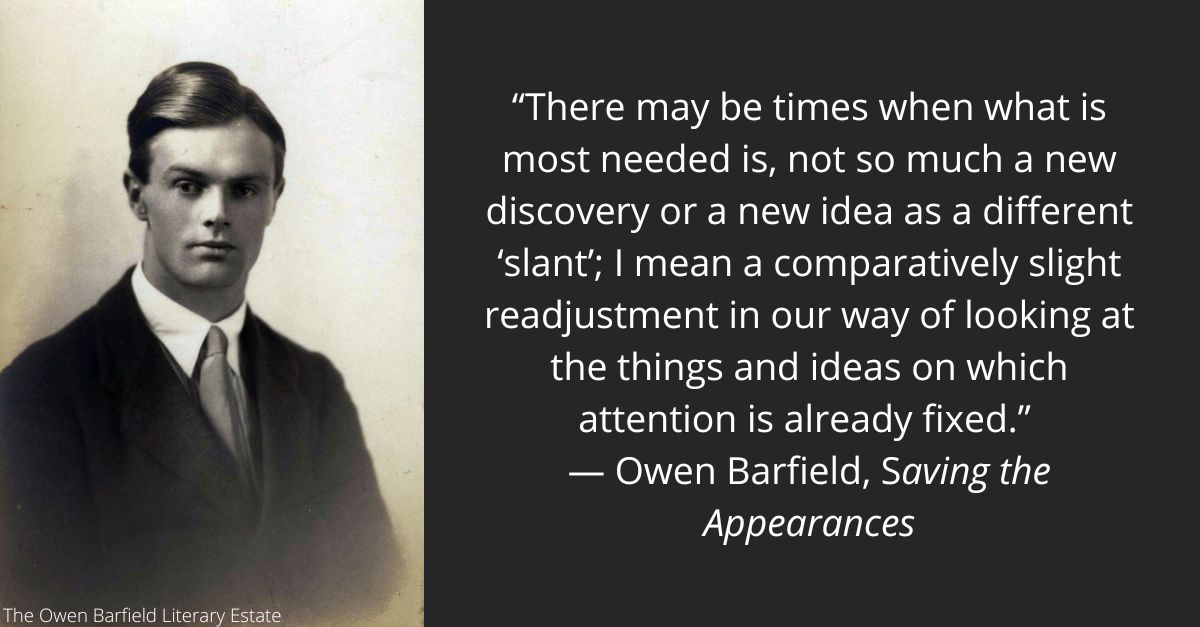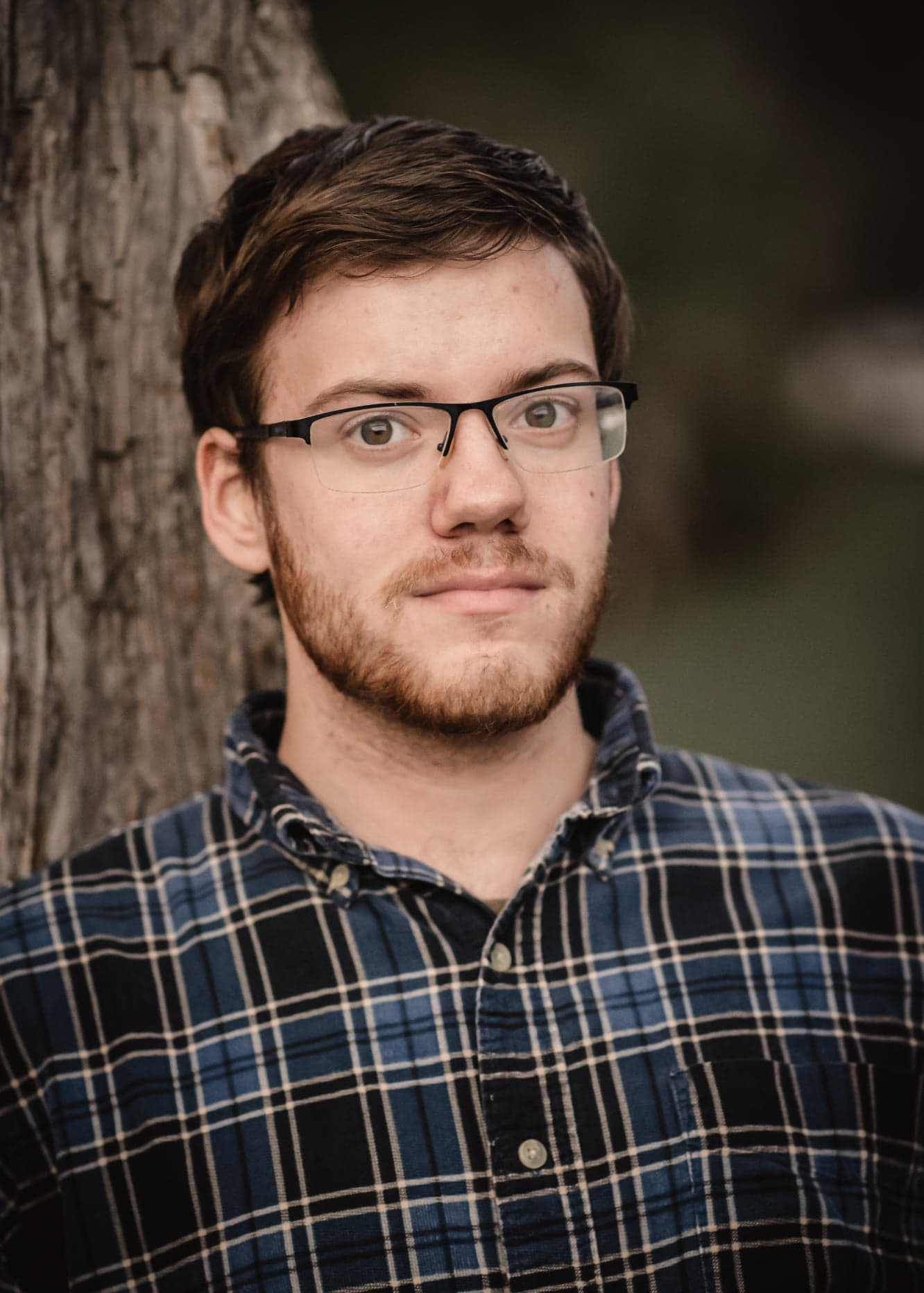If you’ve read many C.S. Lewis biographies, you’ve probably noticed an interesting figure: Owen Barfield, the Oxford classmate who convinced Lewis that atheism wasn’t enough. Their debates about the natural and supernatural led Lewis down a new road to Christianity, with help from Lewis’ other friends, J.R.R. Tolkien and Hugo Dyson.
Why Don’t More People Know about Owen Barfield?
Like Lewis, Barfield explored philosophical and religious themes by writing poetry, fiction, and nonfiction. However, Barfield struggled for many years to find an audience for his work. Part of the problem was, as Jeanne Clayton Hunter and Thomas Kranidas observe in A Barfield Sampler, he “burned some very important bridges by the time he was in his mid-twenties.” Specifically, Barfield burned bridges by choosing niche subjects and philosophies. T.S. Eliot described his book Worlds Apart as “A journey into seas of thought very far from ordinary routes of intellectual shipping.” Being unique made Barfield interesting but not mainstream enough to support himself as a writer.
After publishing several books and some literary criticism in his twenties, Barfield went to work in his father’s law firm. He kept in touch with Lewis and occasionally attended meetings of the Inklings, Christian Oxford intellectuals who shared their writings. Scholars have dubbed him one of the four major Inklings, alongside Lewis, J.R.R. Tolkien, and Charles Williams.
Near the end of his life, Barfield became better known. His admirers included poets W.H. Auden and Howard Nemerov, novelist Saul Bellow, and historian Morris Berman. Since his death, Barfield’s work has continued to attract supporters. His book Saving Appearances made HarperCollins list of 100 best spiritual writings of the 20th century. Contemporary fans of his work include Richard Rohr, Gary Lachman, and Malcolm Guite.
10 Important Events in the Life of Owen Barfield
1. On November 9, 1898, Barfield was born in London to Elizabeth and Arthur Edward Barfield. His parents were fond of music and books, his mother was a Suffragette, and his father was a lawyer.
2. In 1919, while studying at Oxford, Barfield met Lewis through a mutual friend. Their friendship lasted until Lewis died in 1963.
3. In 1923, Barfield married dancer and costume designer Maud Douie. They adopted two children, Alexander and Lucy, and later fostered a second son, Geoffrey.
4. In 1924, after reading philosopher Rudolf Steiner’s work, Barfield attended a Steiner lecture and became a full-fledged follower of Steiner’s philosophy, anthroposophy.
5. In 1928, Barfield published Poetic Diction, which influenced both Tolkien and Lewis.
6. In 1930, Barfield entered his father’s law firm. He continued working there until 1959 and served as Lewis’ lawyer.
7. In 1949, Barfield was baptized into the Church of England.
8. In 1957, Barfield published Saving the Appearances. The book didn’t receive many reviews but proved to be the watershed moment in his writing career, gaining praise from acclaimed writers like Saul Bellows.
9. In 1964, Barfield became a visiting professor at Drew University in New Jersey. Over the next 20 years, he would teach at Brandeis University, Hamilton College, and other institutions. His final lecture in America was a 1984 speech at the Rudolf Steiner Institute in Chambersburg, Pennsylvania.
10. On December 14, 1997, Barfield died at 99 years old. He was the last major Inkling to pass away (only Colin Graham Hardie outlived him).

10 Quotes by Owen Barfield
1. “Science deals with the world which it perceives but, seeking more and more to penetrate the veil of naïve perception, progresses only toward the goal of nothing, because it still does not accept in practice (whatever it may admit theoretically) that the mind first creates what it perceives as objects, including the instruments which Science uses for that very penetration. It insists on dealing with ‘data,’ but there shall be no data given, save the bare precept. The rest is imagination. Only by imagination therefore can the world be known.” — Poetic Diction
2. “The habit of distinguishing sharply between facts and theories is, I think, a good one to acquire in a scientific age.” — Romanticism Comes of Age
3. “There may be times when what is most needed is, not so much a new discovery or a new idea as a different ‘slant’; I mean a comparatively slight readjustment in our way of looking at the things and ideas on which attention is already fixed.” — Saving the Appearances
4. “[Lewis] says in Surprised by Joy that he believes I influenced him more than he influenced me. If that is true, which I very much doubt, it is because he made it possible.” — Owen Barfield on C.S. Lewis
5. “I am a little tired of literature which can do nothing but point out ironically that there is nothing much going on but disintegration and decay.” — 1924 letter to T.S. Eliot
6. “It was not only Mr. [John] Lawlor, in his youth, who felt in his conversations with Lewis that he was wielding a peashooter against a howitzer. I have felt much the same all my life.” — Introduction to Light on C.S. Lewis
7. “… the most fundamental assumptions of any age are those that are implicit in the meanings of its common words.” — The Speaker’s Meaning
8. “You will sometimes hear people say they have no metaphysics. Well, they are lying. Their metaphysics are implicit in what they take for granted about the world. Only they prefer to call it ‘common sense.’” — History, Guilt, and Habit
9. “The house of poetry contains many mansions. These mansions are so diverse in their qualities and in their effect on the indweller and some of them are so distant from others that the inhabitants of one mansion have sometimes been heard to deny that another is part of the same building at all.” — Essays Presented to Charles Williams
10. “In the common words we use every day the souls of past races, the thoughts and feelings of individual men stand around us, not dead, but frozen into their attitudes like the courtiers in the garden of the Sleeping Beauty.” — History in English Words
10 Things You Should Know about Owen Barfield
1. His children are mentioned in Narnia books. Lewis dedicated the first book in the Narnia series to Barfield’s daughter, Lucy. The third book was dedicated to Barfield’s foster son, Geoffrey. Lewis dedicated The Allegory of Love to “Owen Barfield, wisest and best of my unofficial teachers.”
2. He helped lead C.S. Lewis to Christianity. It was a conversation with Tolkien and Dyson that convinced Lewis to embrace theism. However, Lewis said his discussions with Barfield laid the groundwork for him to give up atheism. In The Allegory of Love, Lewis stated that Barfield “taught me not to patronize the past, and has trained me to see the present as itself a period.” This helped Lewis see that older, pre-Enlightenment views of life that allowed for the supernatural may be correct.
3. He wasn’t a typical Inkling, but he was an Inkling. Barfield’s philosophical interests set him apart from Lewis and other Inklings in some clear ways. Also, his London job meant he only attended about one Inklings meeting per Oxford semester. However, his consistent attendance makes it reasonable to call him a regular member instead of a guest. The Barfield Estate’s website refers to him as “the First and Last Inkling,” highlighting how he outlived Lewis, Tolkien, and Williams.
4. He didn’t agree with Lewis on everything. In Surprised by Joy, Lewis refers to Barfield as not the first kind of friend (one with similar opinions) but the second kind: “The man who disagrees with you about everything.” Their friendship involved common interests but often differing conclusions and much debate on which had the right conclusion. Lewis and Barfield debated many subjects, not always changing each other’s minds, but maintaining a friendship and respect for each other.
5. He helped Lewis give money away. Barfield found his work as a lawyer frustrating (in Light on C.S. Lewis, he described “my move to London and into captivity”), but it had one interesting benefit. He became Lewis’ lawyer, which helped them stay in touch. One of Barfield’s notable duties was overseeing the Agape Fund, where Lewis gave away two-thirds of his book royalties to charitable causes.
6. He found success late in life. In The Fellowship, Philip and Carol Zaleski describe how Barfield’s work finally received critical attention in the 1960s. As Barfield taught at American universities, the 1960s zeitgeist for alternate spirituality led to new legions of readers, including counterculture figures like Theodore Roszak.
7. He had other famous friendships. While Lewis was Barfiel’s longest-lasting friendship, he wasn’t his only literary friend. In 1945, he befriended author Walter de la Mare, one of several people who encouraged Barfield in his discouraged periods. In the mid-1970s, Barfield exchanged many letters with novelist Saul Bellows about anthroposophy.
8. He maintained a belief in Christianity and Anthroposophy. Barfield entered the Church of England when he was baptized in 1949, which he didn’t see as inconsistent with his commitment to anthroposophy. The Owen Barfield Estate details how his interest in human consciousness led him to accept Christianity and his views on holding his belief in Jesus Christ alongside Steiner’s teachings.
9. He wrote an important book on Coleridge. One of Barfield’s notable academic contributions was What Coleridge Thought, published in 1971. Biographer Simon Blaxland de Lange explains how Coleridge wasn’t an easy writer to study at that time. The Collected Works of Samuel Taylor Coleridge didn’t start appearing until 1969. When Barfield gave a lecture on Coleridge in 1964, he had to work with quotes from a Coleridge manuscript in the British Library. Coleridge expert Craig Miller introduced Barfield at a 1978 event at the University of British Columbia by saying, “Of all the men I know, he comes closest being a modern-day Coleridge.”
10. He wrote fantasy and science fiction. Barfield’s poetry and nonfiction may be his best-known work, but he also wrote speculative fiction. The Silver Trumpet is a fantasy novel about a dwarf, a prince, and a good witch who stop an evil princess from killing her sister and taking over the kingdom. Night Operation is a science fiction novella about people forced to live in an underground dystopian society… and what happens when one resident discovers the outside world through reading forbidden books.

10 Books by Owen Barfield
The following are 10 of Barfield’s books to start with, covering a wide range of his work.
6. Eager Spring
8. Owen Barfield on C.S. Lewis
9. The Tower: Major Poems and Plays
10 Great Books on Owen Barfield
1. The Inklings by Humphrey Carpenter
2. The Fellowship by Philip Zaleski and Carol Zaleski
3. The Company They Keep (or the associated book Bandersnatch) by Diana Pavlac Glyer
4. The Role of Imagination in Culture and Society: Owen Barfield’s Early Work by Astrid Einer
5. C. S. Lewis’ ‘Great War’ With Owen Barfield by Lionel Adey
6. Why the World Around You Isn’t as It Appears by Albert Lindeman
7. Joy and Poetic Imagination by Stephen Thorson
8. Owen Barfield: Romanticism Come of Age - A Biography by Simon Blaxland-de Lange
9. Owen Barfield: Philosophy, Poetry, and Theology by Michael Vincent Di Fuccia
10. The Inklings and King Arthur, edited by Sorina Higgins
Further Reading:
Who Were the Inklings Besides C.S. Lewis and J.R.R. Tolkien?
Why Was Charles Williams the Odd Inkling?
10 Things You Need to Know about Dorothy L. Sayers
10 Things You Need to Know about G.K. Chesterton
10 Things You Need to Know about Ronald Knox
Cover Photo Credit: Provided with permission of the Owen Barfield Estate. Do not reuse without permission.

This article is part of our People of Christianity catalog that features the stories, meaning, and significance of well-known people from the Bible and history. Here are some of the most popular articles for knowing important figures in Christianity:
How Did the Apostle Paul Die?
Who are the Nicolaitans in Revelation?
Who Was Deborah in the Bible?
Who Was Moses in the Bible?
King Solomon's Story in the Bible
Who Was Lot's Wife in the Bible?
Who Was Jezebel in the Bible?
Who Was the Prodigal Son?









